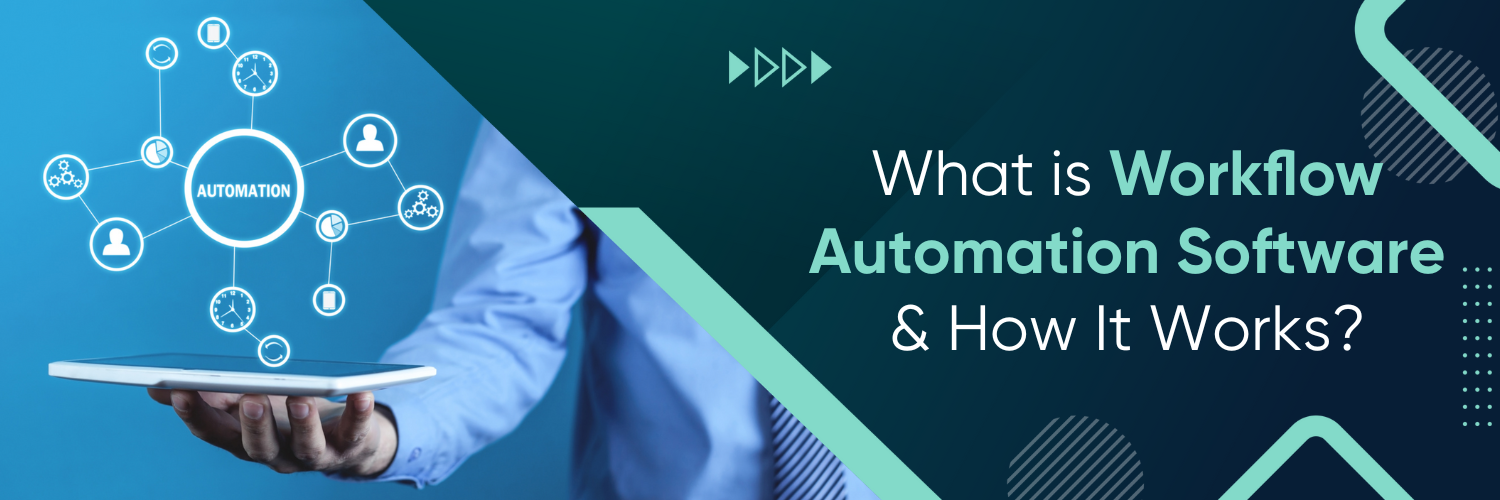What is a Workflow Automation Software?
Workflow Automation Software has emerged as a vital tool in this pursuit. This sophisticated technology simplifies and streamlines routine tasks, freeing up resources and optimizing operational efficiency. Let’s delve into the world of Workflow Automation Software and uncover how it can revolutionize the way we work.
A workflow is a sequence of tasks that processes a set of data. Workflows are pervasive in any business, from the approval process for a vacation request to the steps required to process an invoice. Automation, on the other hand, is the application of technology to execute tasks with minimal human intervention. Workflow Automation Software, therefore, is a tool that enables businesses to automate routine tasks, making processes faster, less prone to error, and more efficient.
Workflow automation has its roots in the industrial revolution, where mechanization began replacing manual labor. The advent of the computer and the internet provided the necessary tools for further evolution. Modern Workflow Automation Software is a culmination of these technological advancements, leveraging powerful features like cloud computing, AI, machine learning, and more to automate complex processes.
Benefits of Using Workflow Automation Software
The advantages of Workflow Automation Software are numerous. It significantly increases efficiency by automating repetitive tasks, freeing up employees’ time for more strategic activities. It reduces errors by minimizing manual intervention, thereby enhancing the accuracy of outputs. By creating transparent and standardized processes, it enhances collaboration across teams and departments. It helps ensure compliance by maintaining comprehensive audit trails. Workflow Automation Software provides numerous benefits including:
- Increasing Efficiency: By automating repetitive tasks, businesses can focus on core competencies.
- Reducing Errors: Automation reduces the likelihood of human error.
- Enhancing Collaboration: It allows for seamless collaboration between departments and teams.
- Facilitating Compliance: Helps in maintaining compliance by ensuring that all processes are executed according to the set standards.
- Improving Employee Satisfaction: Employees can focus on more meaningful tasks, leading to increased job satisfaction.
Components of Workflow Automation Software
Workflow Builder
A Workflow Builder is an essential component of any Workflow Automation Software, allowing users to define the steps in a workflow. It can be visual or text-based, catering to different user preferences and complexity levels. Some software also provides template libraries to expedite the workflow creation process.
Visual Workflow Builders
Visual Workflow Builders offer a user-friendly interface with drag-and-drop tools. This enables users, even those without technical expertise, to easily create and modify workflows. The visual representation simplifies the workflow design process, making it accessible to a wider range of users.
Text-Based Workflow Builders
Text-Based Workflow Builders are ideal for users with technical knowledge or more complex workflow requirements. They provide greater flexibility and control over the design and customization of workflows. Users can define intricate logic and conditions using programming or scripting languages.
Template Libraries
Workflow Automation Software often includes template libraries, offering pre-built workflow templates for common use cases. These templates serve as starting points, allowing users to leverage industry best practices and save time in designing workflows. They can be customized to suit specific business needs, streamlining the workflow creation process.
Task Automation
Task Automation is a fundamental feature of Workflow Automation Software. It enables the definition and execution of tasks based on various triggers, schedules, or conditions.
- Trigger-Based Tasks: Trigger-Based Tasks initiate when specific events occur. For instance, tasks can be triggered by events such as the receipt of an email, a new entry in a database, or the completion of a preceding task. This automation allows for immediate response and workflow progression.
- Scheduled Tasks: Scheduled Tasks are designed to run at predefined times or intervals. For example, a task can be scheduled to execute daily, weekly, or monthly. This functionality is useful for tasks such as generating reports, performing backups, or sending regular notifications.
- Conditional Tasks: Conditional Tasks execute based on specific conditions or criteria. Users can define rules that determine whether a task should be executed or skipped. For instance, if an invoice amount exceeds a certain limit, the workflow can automatically route the invoice for additional approval. Conditional tasks add flexibility and adaptability to workflows.
Data Management
Data Integration
Data integration capabilities allow workflows to interact with various data sources, including databases, cloud storage, and external applications. This integration ensures a smooth and continuous flow of data between different systems, enabling efficient and accurate execution of workflows.
Data Storage
Workflow Automation Software ensures secure storage of all data associated with workflows. This includes storing input data, intermediate results, and output data in a centralized and organized manner. Data storage capabilities ensure data integrity, accessibility, and data governance within the workflow automation system.
Data Analytics & Reporting
Data analytics and reporting tools provided by Workflow Automation Software enable users to track and analyze the performance and efficiency of workflows. These tools provide insights into key metrics, such as task completion times, bottlenecks, and resource utilization. Reporting functionalities allow for the generation of customized reports, providing stakeholders with valuable information for process improvement and decision-making.
Notification and Communication Tools
Workflow Automation Software includes notification and communication tools to facilitate timely and effective communication within workflows.
Alerts
Alerts are used to notify users about critical events or exceptions occurring within workflows. These alerts can indicate errors, task completion, or any other important notifications that require immediate attention. Alerts ensure that relevant stakeholders are promptly informed of workflow progress and any potential issues that may arise.
Emails
Integration with email systems enables workflows to send, receive, and process emails as part of the automation process. This functionality allows for seamless communication with external parties, such as clients, suppliers, or employees involved in the workflow. Email integration enhances collaboration and enables the automation of email-based tasks and notifications within workflows.
Approval Requests
Approval requests play a crucial role in workflows that require decision-making or authorization. Workflow Automation Software includes features to generate and manage approval requests, routing them to the appropriate individuals or teams for review and approval. This ensures that necessary approvals are obtained efficiently and that the workflow progresses smoothly.
How Workflow Automation Software Works
To effectively implement Workflow Automation Software, businesses follow a systematic process.
Process Mapping
The first step involves mapping out the existing processes within the organization. This entails identifying the steps, decision points, and participants involved in each workflow. Process mapping provides a clear understanding of the workflow structure and identifies areas for improvement and automation.
Workflow Design
Using a Workflow Builder component of the software, businesses design the automated workflow. This involves translating the mapped-out process into a series of automated tasks, defining dependencies, conditions, and triggers. The Workflow Builder provides an intuitive interface, allowing users to visually or textually define the workflow logic.
Configuration and Customization
Once the workflow design is complete, businesses configure the workflow to meet their specific requirements. This includes customizing the workflow’s behaviour, integrating with relevant systems and applications, and setting up user roles and permissions. Configuration ensures that the workflow aligns with the organization’s unique processes and enhances compatibility with existing systems.
Testing
Before full implementation, thorough testing is essential to identify and rectify any issues or potential errors within the workflow. Testing involves running the workflow with sample data and scenarios, evaluating its performance, and verifying its accuracy. This step ensures that the automated workflow functions as intended and meets the desired outcomes.
Implementation
Once the workflow has been tested and validated, it is ready for implementation. This involves launching the workflow and making it operational within the organization. During implementation, users receive adequate training on using the workflow automation software and understanding their roles within the automated processes. Ongoing support is provided to address any questions or challenges that may arise during the initial implementation phase.
Use Cases & Examples
Human Resources Onboarding
Automating the HR onboarding process streamlines the transition for new hires, reducing manual effort and ensuring a consistent and efficient onboarding experience. Workflow automation software can automate tasks such as sending welcome emails, generating and distributing necessary documents, setting up accounts and access privileges, scheduling orientations and training sessions, and tracking progress. This automation saves time, minimizes errors, and enhances the new employee’s experience.
Invoice Processing
Automating invoice processing improves accuracy, reduces processing time, and enhances the visibility and control over financial operations. Workflow automation software can capture invoice data, validate it against predefined rules, route invoices for approval based on predefined criteria, and integrate with accounting systems for seamless payment processing. By automating these tasks, businesses can reduce manual data entry, eliminate paper-based processes, and improve invoice cycle times.
IT Ticketing System
Automating an IT ticketing system streamlines the process of handling support requests and ensures timely and effective resolution of IT issues. Workflow automation software can automatically assign tickets to the appropriate technicians based on predefined rules, notify users of ticket status changes, and provide real-time visibility into the progress of each ticket. This automation improves response times, reduces manual effort in ticket routing, and enhances overall IT service delivery.
Content Approval Processes
For content creation teams, automating the approval process ensures efficient collaboration, timely feedback, and streamlined content publishing. Workflow automation software can route content for review and approval, notify reviewers of pending tasks, track changes and versions, and manage content publishing workflows. By automating these processes, content creation teams can improve productivity, ensure consistency in content quality, and accelerate time-to-market.
Selecting the Right Workflow Automation Software
Assessing Your Needs
Understanding your workflow requirements involves identifying the specific processes and workflows that need automation. Evaluate the complexity of the workflows, the data sources involved, and the roles and responsibilities of users within those workflows.
Identifying Key Stakeholders
Engage with key stakeholders, such as process owners, department heads, and end-users, to gather their input and understand their needs. Involving them in the selection process ensures that the chosen software meets their requirements and aligns with their workflow objectives.
Evaluating Features
Essential Features
Consider the features that are essential for your workflows, such as ease of workflow design, flexibility in task automation, integration capabilities with other systems, reporting and analytics functionalities, and user-friendly interfaces. Prioritize the features that align with your specific workflow automation goals.
Scalability
Ensure that the workflow automation software can handle the scalability of your workflows. Consider the volume of tasks, complexity, and potential future growth. The software should be able to accommodate increasing workload demands without sacrificing performance or efficiency.
Integration with Existing Systems
Check if the workflow automation software integrates seamlessly with your existing systems and tools. This includes compatibility with your document management systems, databases, email servers, and other relevant applications. Integration capabilities enable smooth data exchange and avoid data silos.
Cost and ROI Analysis
Calculating Return on Investment
Evaluate the potential return on investment by analyzing the time and cost savings, increased productivity, reduced errors, and improved efficiency that the workflow automation software can provide. Quantify the benefits and compare them against the investment required to implement and maintain the software.
Considering Total Cost of Ownership
Besides the initial purchase price, consider the total cost of ownership, which includes implementation costs, training expenses, ongoing maintenance and support fees, and potential future upgrades. Understanding the long-term costs associated with the software helps in making an informed decision and ensuring the solution remains cost-effective over time.
Best Practices for Implementing Workflow Automation Software
Involving the Right People
Engaging the right stakeholders from the beginning is crucial for successful implementation. Identify key stakeholders who are directly involved in the workflows that will be automated and ensure their active participation throughout the implementation process. This includes process owners, department heads, IT personnel, and end-users. By involving the right people, you can gather valuable insights, align the software with business needs, and secure support and buy-in from all stakeholders.
Focusing on the End-User
Prioritizing the end-user experience is essential for widespread adoption and successful implementation of workflow automation software. Consider the needs, preferences, and technical proficiency of the users who will be interacting with the software on a daily basis. Choose a user-friendly software with an intuitive interface and provide adequate training and resources to help users understand the software’s functionalities and maximize its benefits. Solicit feedback from end-users throughout the implementation process to identify areas for improvement and optimize the user experience.
Continuous Improvement and Monitoring
Implementing workflow automation software is not a one-time event but an ongoing process of improvement and optimization. Regularly monitor the performance and efficiency of automated workflows and identify areas that require adjustments or enhancements. Analyze key metrics, such as task completion times, error rates, and user feedback, to measure the effectiveness of the software and identify areas for optimization. Continuously seek feedback from stakeholders and users to gather insights and implement iterative improvements to the automated workflows.
Training and Support
To ensure effective utilization of workflow automation software, provide comprehensive training and ongoing support to users. Offer training sessions or workshops to familiarize users with the software’s features, functionalities, and best practices for workflow design and execution. Provide documentation, user guides, and tutorials to assist users in navigating the software and troubleshooting common issues. Establish a dedicated support channel or helpdesk to address user questions, concerns, and technical issues promptly. Regularly communicate with users to keep them informed about software updates, new features, and best practices.
Conclusion
Workflow automation software plays a vital role in modern business environments. It offers a transformative solution by streamlining processes and automating repetitive tasks. The importance of workflow automation software lies in its ability to significantly increase efficiency, reduce errors, enhance collaboration, facilitate compliance, and improve employee satisfaction. By implementing workflow automation software, businesses can optimize their operations and achieve higher productivity levels. It is crucial to encourage the adoption of workflow automation software and strive for continuous improvement to stay ahead in today’s competitive landscape.
To stay competitive in today’s fast-paced business landscape, it is essential to embrace workflow automation and continuously seek ways to improve and optimize processes. To embark on this journey, we invite you to follow our blog for more insights and guidance. Additionally, for a seamless and successful implementation of workflow automation software, partner with Ubique Digital Solutions, a trusted industry leader. Together, we can help boost your business to new heights of success. Contact us today!
FAQs
Q: What is Workflow Automation Software?
Workflow automation software refers to technology that automates and streamlines business processes, allowing organizations to automate repetitive tasks, improve efficiency, and optimize workflows. It provides tools and features to design, execute, and monitor workflows, eliminating manual effort and enhancing productivity.
Q: How Does Workflow Automation Software Work?
Workflow automation software works by mapping out the steps of a process, defining triggers and actions, and automating the flow of information and tasks. It typically involves the use of visual or text-based workflow builders, task automation capabilities, data management tools, and notification and communication features. Through these components, the software orchestrates and automates the sequential or parallel execution of tasks, ensuring efficient and error-free workflow management.
Q: What are the Benefits of Using Workflow Automation Software?
Using workflow automation software offers numerous benefits. It improves efficiency by eliminating manual and repetitive tasks, reduces errors through standardized and automated processes, enhances collaboration by providing visibility and accountability, facilitates compliance with regulatory requirements, and boosts employee satisfaction by freeing up time for more meaningful work. Overall, workflow automation software empowers businesses to optimize their operations and achieve better outcomes.
Q: How Do I Choose the Right Workflow Automation Software for My Business?
When selecting the right workflow automation software for your business, it is essential to assess your specific needs and requirements. Consider factors such as the complexity of your workflows, integration capabilities with existing systems, scalability for future growth, ease of use, and available customer support. Evaluate the software’s features, customization options, security measures, and pricing models to ensure it aligns with your business goals and budget.
Q: Can Small Businesses Benefit from Workflow Automation Software?
Absolutely! Small businesses can benefit greatly from workflow automation software. It helps them streamline their operations, reduce manual effort, and improve overall efficiency. By automating repetitive tasks and optimizing workflows, small businesses can enhance productivity, minimize errors, and allocate their resources more effectively. Workflow automation software offers an affordable solution that can scale as the business grows, making it a valuable tool for small enterprises seeking to compete in today’s market.























